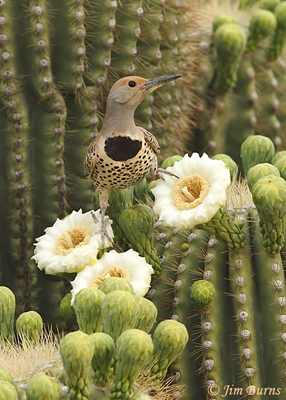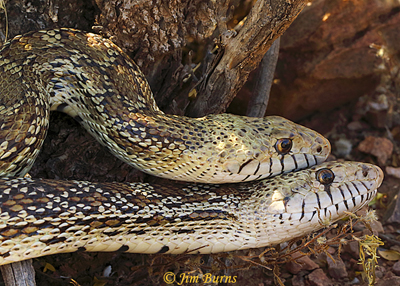
Or perhaps still flying. Nighthawks are crepuscular, of course, and typically hawk insects shortly before dawn and at dusk. This begs the question posed in my previous column: why would ground roosting nighthawks draw the interest of the local Cactus Wrens whose harassment seemed to have put them into the air yesterday in mid-morning, not a typical time of day for them to be on the wing?
On a distant Saguaro I see, through binoculars, a Cactus Wren proclaiming territory with the familiar ratchet call. Somewhere to my left, up near the cliff face, Ash-throated Flycatchers are calling to one another, their rolling trill a welcome sound because I assume they are a mated pair and I will look for their nest in the weeks after the flicker nestlings have fledged.
Giant Saguaro is the desert supermarket. Every morning all the local suspects work the cactus tops seeking insects among the budding fruit. House Finches, Curve-billed Thrashers, and White-winged Doves have already spent time atop the flickers’ Saguaro, and movement in the corner of my eye proves to be the Cactus Wrens landing there. A roadrunner trots down the draw, flushing a Black-tailed Jackrabbit which immediately seeks the shade of another bush. The desert is heating up quickly on what will prove to be our first 100 degree day.
The nighthawks have gone to ground somewhere, and I watch the wrens drop from the Saguaro to a low bush in the vicinity of yesterday’s excitement. They begin buzzing again, flitting about the branches inches above the desert floor. I move three steps and glass beneath the bush into sparse grass, sticks, and boulders, searching intently for the cryptic nighthawk pattern, expecting one to flush any moment.
And then I see it. A glossy, milky band of movement, interspersed with irregular dark patches, flowing, oozing down the wash amongst the desert debris. Gopher Snake! The light bulb comes on. Indeed, the nighthawks were of no interest to the wrens yesterday. The wrens had been harassing a snake, probably this same one, which in turn had flushed the nightjars. The snake, as cryptically camouflaged as the nightjars, had escaped my scrutiny of the desert floor.
And then I see another band of movement, thinner, trailing the first. The bands coalesce and flow together under a low bush. The wrens are going nuts, and thrashers, flickers, and gnatcatchers have joined the fray. All my years outdoors and this is a first for me! Mating snakes. I check carefully to make sure they don’t have rattles, then get down on my knee pads with a macro lens. Snakes are difficult to photograph well. Unless they are coiled, in order to capture their entire length the camera must be far enough away that the granular beauty of their heads, scales, and nuances of color shading is lost. I opt for head shots and close-ups of their twined tails where the copulatory organs are located.
The last Gopher Snake I encountered wanted no part of me, striking and shaking its tail in rattlesnake simulation. This pair, intent on their business, pays me little notice as I admire them, inches away, heads in full frame through the macro lens. The birds have all dispersed, perhaps because of my presence, maybe because the snakes have wound themselves completely around the base of the bush, no longer slithering across the landscape.
It’s been a good two days at the new office. The workspace is quite an upgrade, roomy, well-appointed, and it overlooks scenic natural beauty. It’s never boring, full of challenging questions, and conducive to learning. And every day I’m here my understanding and appreciation grows for those who share the workplace.